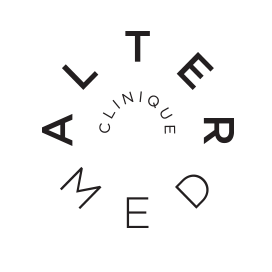Clinique Altermed
Montreal osteopathy Montreal masso-kinesitherapy
Your baby is having difficulty breathing, suffers from congestion in the airways and his lungs seem congested.
The symptoms observed are "crackling" noises in your child's breathing... these noises may be accompanied by wheezing and indicate respiratory congestion. These noises are easily heard by putting your ear to the chest or back. In cases of bronchopulmonary congestion, the health care system will respond effectively to the problem in the sense that it will work to ensure a good stability of the child's respiratory vital signs (free breathing usually controlled by taking anti-inflammatory and bronchodilator medication... antibiotic therapy can also be undertaken).
With our approach, we propose to go further while remaining complementary: indeed, experience shows that the practice of respiratory physiotherapy of bronchial decongestion allows to free more quickly the respiratory system of these bronchial secretions which maintain the inflammation and the malaise of the child.
WHAT ARE THE TECHNIQUES USED
FIRST STEP:
Ensure that the upper airways are free... that is, the nose.
Indeed, the toddler, under three months, breathes only through the nose, and therefore any prolonged nasal obstruction can lead to major respiratory distress. After three months and up to the age of two, the risk remains, even if it is less. It is therefore advisable to ensure that parents have a good command of their baby's nose blowing.
SECOND STEP :
Accurate assessment of congestion by medial auscultation (i.e., using a stethoscope). This allows for a more accurate assessment of the levels of congestion and severity. Clinical observation finally allows us to assess the stability of the child's vital signs and thus allow us to decide to treat or refer to the physician or hospital if respiratory failure is detected.
STEP THREE:
If the child is stable and can be treated, then we will proceed with gentle maneuvers that help clear the bronchopulmonary system... This is Expiratory Flow Augmentation.
AFE: Augmentation of the Expiratory Flow.
More efficient and less traumatic than the classic clapping, these maneuvers will allow, in an incitement towards the prolonged expiration of the child, to make secretions go up until the tussigenic zone of the bronchi... the child will then cough and swallow. The secretions will be evacuated by the digestive system (the parents will be able to observe afterwards mucusy stools in the diapers). In case of more abundant secretions, we also have specific maneuvers that will allow these secretions to migrate to the mouth and to be evacuated simply with a handkerchief.
These maneuvers are not at all painful for the child, but simply tiring. For this reason, the session includes many breaks in order to respect the child's rhythm and sensitivity. The maneuvers will be beneficial for 24 to 48 hours and will promote a natural elimination of the lungs.
WHY IS THIS PROCEDURE COMPLEMENTARY?
The bronchopulmonary system has three ways of reacting to an aggression (generally viral)
-
Inflammatio
-
Spasm
-
Hypersecretion
The medical system will mainly act on inflammation and spasm by using drugs (e.g. Flovent for inflammation, Ventolin for spasm). Hypersecretion is usually only taken into account when the child is in respiratory failure...and it is often in the hospital that a management will allow to restore a balance in the bronchopulmonary system.
Indeed, inflammation and spasm will promote hypersecretion: this is the vicious circle that maintains bronchial congestion and leads to chronic congestion and even respiratory failure. Chronic congestion is also one of the factors that can promote a chronic inflammatory state of the bronchial tubes and a progressive deterioration towards an asthmatic state.
Do not hesitate to consult other alternative disciplines in order to link these dysfunctional respiratory problems to one or more other local or remote causes, more or less rooted in time and in the history (and course) of your child.


